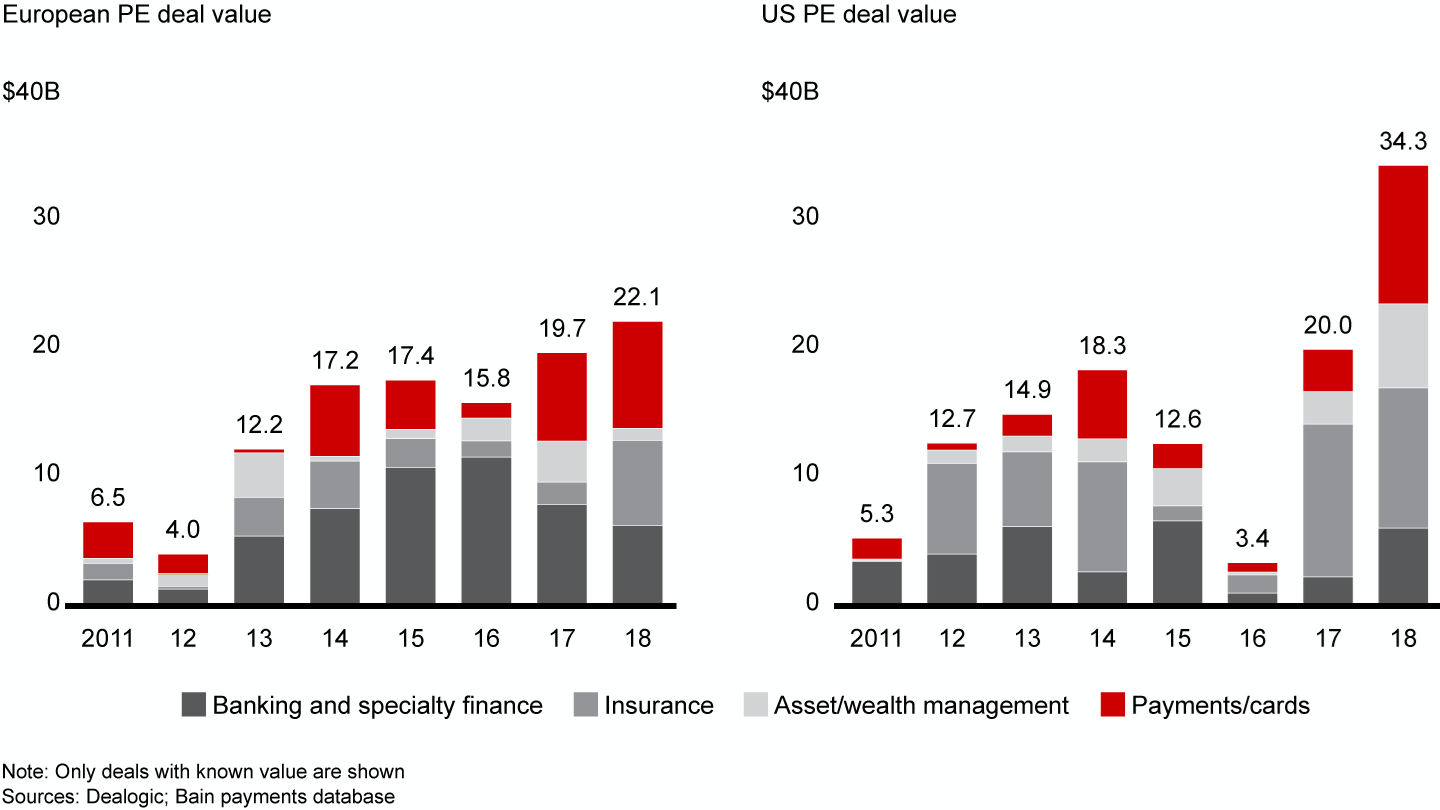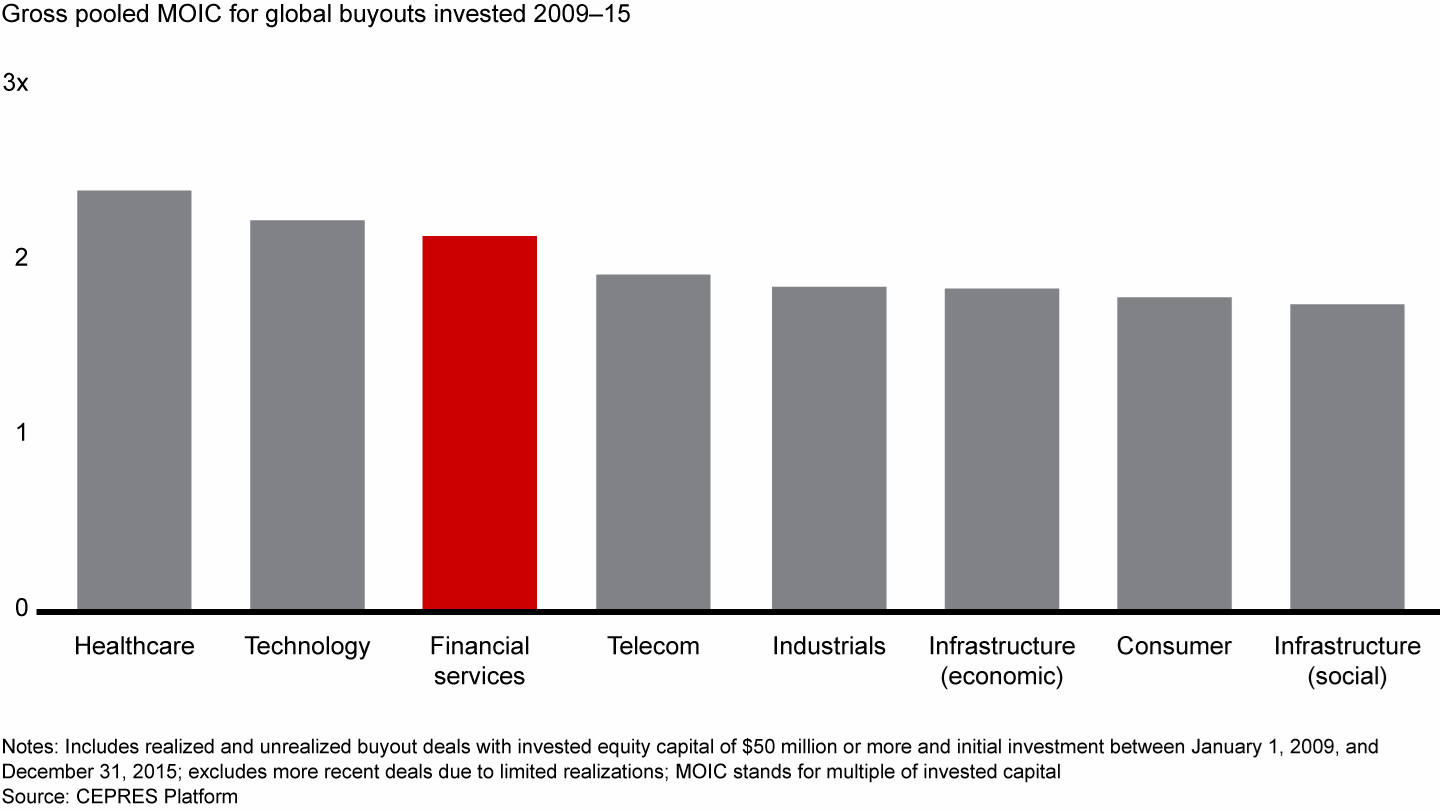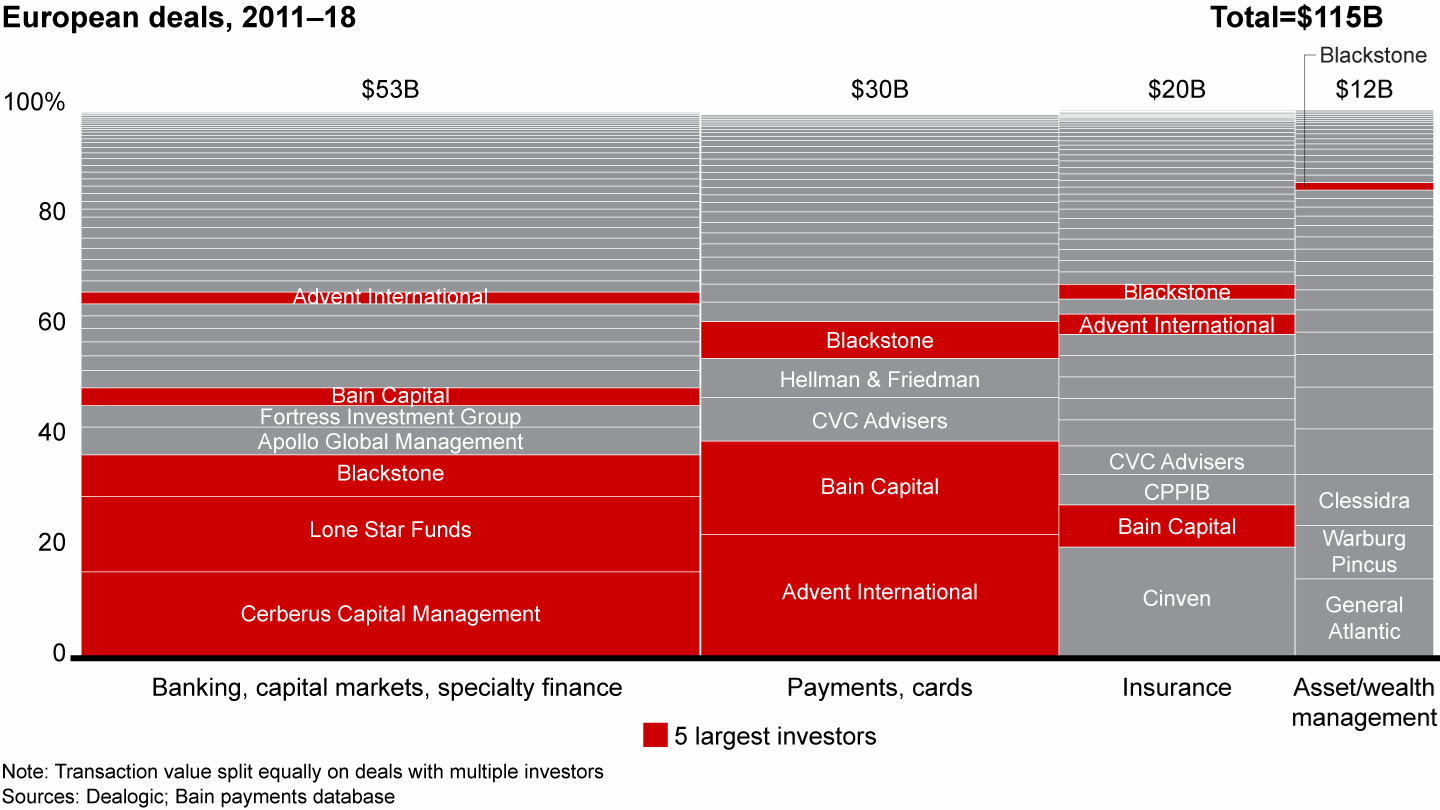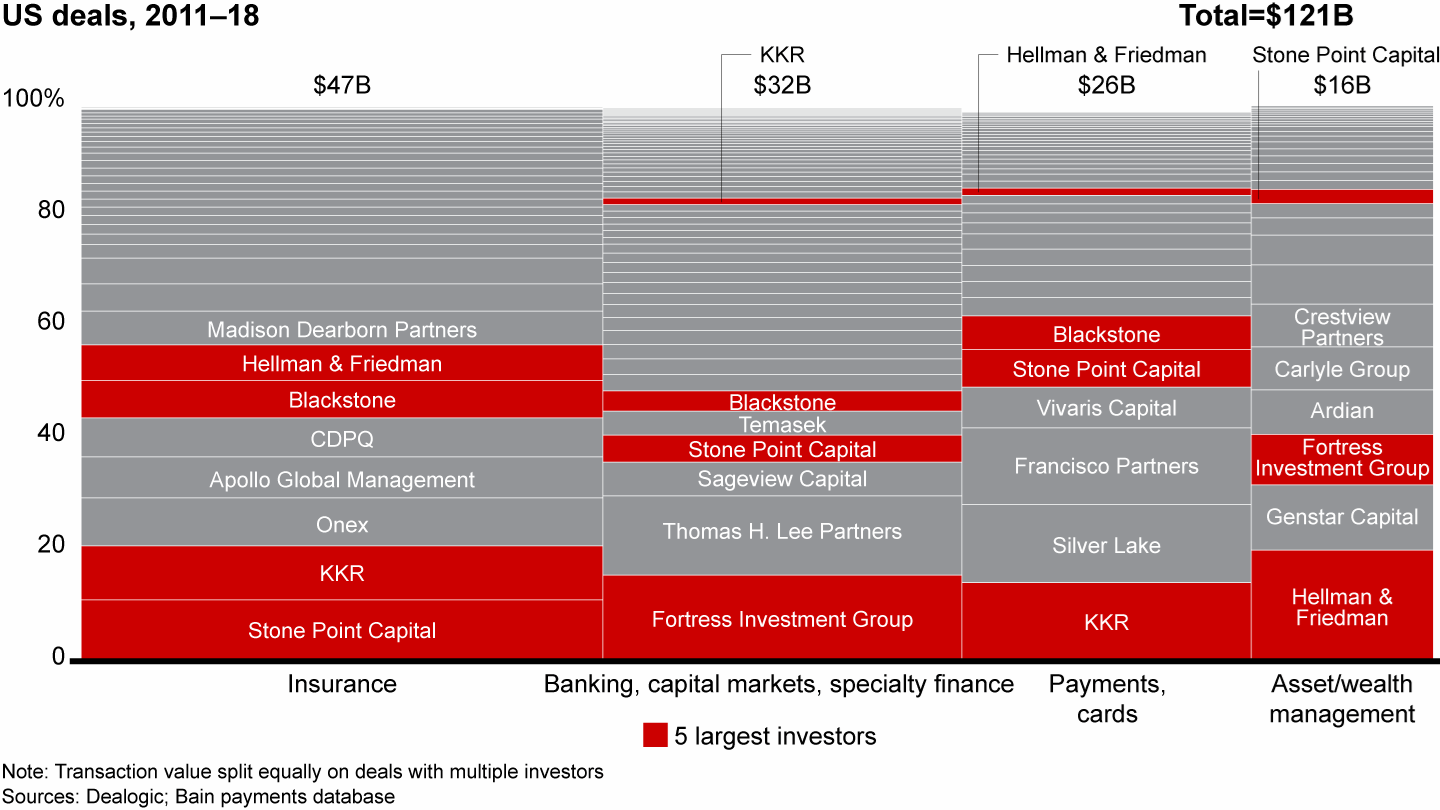Brief

Executive Summary
- Financial services deals in private equity have grown on the back of strong returns, including a pooled multiple on invested capital of 2.2x in recent years, higher than all but healthcare and technology deals.
- With a recession increasingly likely during the next holding period, PE funds need to develop plans to weather any storm and potentially improve their competitive position during and after the downturn.
- Many leading funds are investing in balance-sheet-light assets enabled by technology and regulatory change.
- Diligences now should test target companies under stressful economic scenarios and lay out a detailed value-creation plan, including how to mobilize quickly after acquisition.
Financial services deals by private equity funds have had a strong run over the past few years, with deal value increasing significantly in Europe and the US (see Figure 1). Returns have been strong as well. Global financial services deals realized a pooled multiple on invested capital of 2.2x from 2009 through 2015, higher than all but healthcare and technology deals (see Figure 2).
Both US and European private equity markets have seen strong growth in financial services deals


Financial services deals have generated relatively high returns since the financial crisis


Now, however, an economic shadow is creeping over prospects for investments. Financial services took a harder hit than many other industries during the past two recessions. And with most PE funds modeling a mild downturn or slowdown during the next holding period, investors will want to develop prerecession plans to weather the storm and potentially improve their competitive position during and after the downturn.
Promising fundamentals
The good news is that the fundamental rationales for investing in financial services assets continue to be solid. To start, challenger companies have been encouraged by increased regulatory intervention, such as the Payment Services Directive and MiFID II in Europe; greater enforcement of anti-money-laundering and know-your-customer rules in banking and insurance; and heightened supervision of registered investment advisory firms in the US.
Technology also comes into play. Greater use of mobile devices has spurred a new generation of fintechs in banking, payments, insurance and wealth management. The burgeoning sharing economy, which includes ride sharing and house sharing, is redefining the scope of property and casualty risk. Further out, telematics, the Internet of Things and artificial intelligence will improve underwriting.
Finally, demographic trends could be beneficial. For instance, aging populations in many countries will lead to further restructuring of pensions and life insurance schemes, greater demand for wealth management, and more lending opportunities such as reverse mortgages.
Where investments are headed
In response to these underlying trends, we are seeing a greater number of specialized PE funds or fund teams focused on specific subsectors for deal underwriting (see Figures 3 and 4). We expect balance-sheet-light deals to become even more attractive in the near future. Funds will continue to gravitate toward assets that move along the S curve of growth, such as online payments and fund administration. Such assets may thrive even during an economic slowdown.
In Europe, PE funds have increasingly specialized in subsectors of financial services


PE funds have pursued subsector specialization in the US as well


Let’s look at a few plays underway in select subsectors.
Payments. Funds are ramping up their investments in new geographies and putting a greater focus on business-to-business payments in niche verticals such as hotel commissions and airline travel. Bain Capital’s minority stake in the combined healthcare technology companies Zelis and RedCard is a good example. We also see expansion of payments into lending for merchant cash advances and invoices, as well as provision of services to the longer tail of bank-owned merchant acquirers.
Investment theses include go-to-market improvements of the base business, which KKR is doing with Heidelpay; scale consolidation, as with the merger of Nets and Concardis; and the integration of electronic payments into business-management software platforms, which underpins transactions including Advent’s acquisition of Clearent and Vista’s purchase of Mindbody.
Insurance underwriting and distribution. Deal theses in this subsector include digitalizing the customer experience, as with CPPIB’s investment in BGL Group. Others aim to improve the Lloyd’s of London market and the managing general agent space, including Altamont’s investment in Accelerant, General Atlantic in Hyperion, Centerbridge in Canopius, Preservation Capital in BMS, and Vitruvian in CFC.
Another strategy has been to roll up closed life-insurance books to cut costs and improve investment performance—take Apollo with Athene and Athora, for instance. In the US, much of the action has come in distribution, as illustrated by Hellman & Friedman’s investment in HUB International and Stone Point Capital’s investment in Alliant.
Debt recovery. Some funds are looking to consolidate the fragmented debt-recovery market, including Permira with Lowell Group, although others will avoid the potential reputational risk.
Wealth management. Deal theses in wealth management resemble those in insurance, but with more runway remaining in the shift from captive distribution to independent distribution models. This breakaway trend is fueled by large-scale independent broker/dealer and registered investment adviser custodial platforms, which can provide a nearly turnkey setup for independent producers. As a result, we have seen a proliferation of smaller independent wealth managers, some of whom now feel burdened by rising compliance costs and the complexities of recent regulatory reforms and want to sell their practices to larger independents.
In addition, firms such as Mercer and United Capital are harmonizing back-office and technology operations. As their office footprint approaches national scale, they are reaping client referrals from relationships with partners on their platforms. No longer simply a collection of personal producer books, these aggregator platforms offer a more attractive split of profits between producer and platform, thanks to the value of referral flows.
Trust and corporate services. Most PE investments in this subsector aim for consolidation, including SGG’s acquisition of First Names and Augentius; Alter Domus’ acquisition of Cortland; and Apex Group’s acquisition of Link Asset Services’ corporate services business, Ipes and others. We expect to see funds focus on commercial excellence with current portfolio companies while embarking on the next wave of megamergers. The fund administration and international expansion aspects of this subsector appeal on both the balance sheet and economic cycle fronts.
Specialty finance. While this subsector tends to be more exposed to economic headwinds, funds will continue to seek consolidation of specialty finance and challenger banks, with an eye to rolling up new entrants to gain a more sustainable return on equity. Examples include CVC and Cinven investing in NewDay, and Värde Partners acquiring WiZink.
Bank, capital markets and insurer software. Investors have been seeking to generate returns from increased adoption of third-party software and of new technologies such as artificial intelligence. Examples include Bridgepoint and Summit Partners’ investments in Primonial, Warburg Pincus in Avaloq, and Carlyle in ION.
Noncore banking activities. Over the past several years, many deals have focused on extracting noncore assets from banks. Recent examples are fund platforms (Hellman & Friedman investing in Allfunds) and appraisers (Advent and then Cinven in Tinsa). Opportunities remain for further carve-outs, especially if bank balance sheets come under pressure.
Only a small share of investments will outperform, of course. As the public markets have demonstrated, it’s critical to pick the right company; there is a large disparity in total shareholder return between the best and worst performers in any subsector.
Planning ahead for value creation
Astute fund managers realize the value of preparing for any downturn now, before their portfolio companies feel the pain. Regardless of subsector, funds would do well to analyze companies’ income and balance sheets under stressful economic scenarios. And it’s worth giving extra scrutiny to asset groups that haven’t yet seen a recession, such as many peer-to-peer lenders.
Without economic tailwinds to rely on, funds must devote even more effort to laying out the value-creation plan during due diligence, including how they will mobilize quickly after acquisition. This typically includes assessing the benefits of commercial excellence and planning the investments required in digital and technology.
During diligence, funds will also want to conduct a “future back” assessment of the digital disruption that could affect a business model. How might digital shift customer needs, cost structures, the value of data, ecosystems and the rate of entry of new competitors?
As we move to a new stage in the economic cycle, it’s not enough to know a subsector well. Funds should understand how a company will fare financially and competitively, and test the business against robust recession scenarios. This means having a firm grasp of how far earnings can fall, for how long, and exactly what levers an owner can employ to minimize the damage. It is essential to build a balance sheet that can withstand a period of economic weakness. It’s also critical to understand the company’s core strengths and construct a value-creation plan to take advantage of them.
Tim Cochrane, Justin Miller, Michael Cashman and Mike Smith are partners with Bain & Company’s Financial Services and Private Equity practices. They are based, respectively, in London, New York, Boston and London.